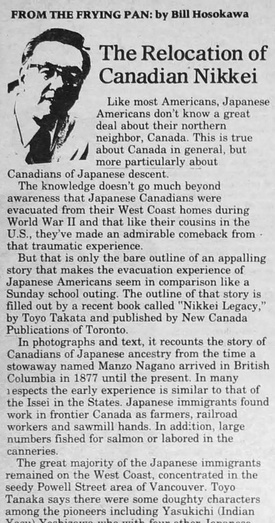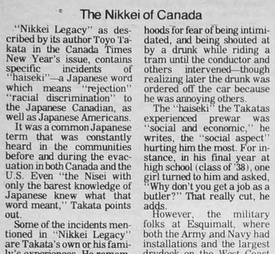Recently, I have been researching the life of Toyo Takata. The late Japanese Canadian journalist and author was a leading voice within the postwar Japanese Canadian community, working as the editor of the community newspaper The New Canadian from 1949 to 1951 and as a columnist from 1949 until his retirement in the 1980s.
Originally born in Victoria, BC, Takata and his family were incarcerated by the Canadian government in several camps in 1942, first at Hastings Park and later at the inland camps of Sandon and New Denver. In 1945, the Takata family relocated to the greater Toronto area, where they settled permanently. Although Toyo frequently visited his old haunts in Victoria later in his life, he remained in the Toronto area like many Japanese Canadians formerly from British Columbia.
Like other Nisei journalists, such as Hugo Yamamoto or Bill Hosokawa in the U.S., Takata frequently chronicled the history of the Japanese Canadian community in his articles for The New Canadian. Outside of his own reportage for The New Canadian, Takata worked as Canada editor for U.S. Nisei magazines Nisei Vue and Scene.
Toyo’s greatest contribution to Japanese Canadian history, and the product of decades of his journalistic writings, was his 1983 book Nikkei Legacy. Considered by some to be “a bible” of Japanese Canadian history, Nikkei Legacy, alongside Ken Adachi’s more famous study The Enemy That Never Was, reignited interest in the storied history of the Japanese Canadian community amidst the national redress movement (coincidentally, Adachi succeeded Takata as editor for The New Canadian in 1951). With a foreword by famed novelist Joy Kogawa, Nikkei Legacy provided one of the first introductions to Japanese Canadian history.
The book is organized into four parts: early history, settlement and pioneers, evacuation, and resettlement. Although not a general study on Japanese Canadian history, Nikkei Legacy stands out for its collection of individual stories of Japanese Canadians who shaped the community and contributed to Canadian society. Takata devotes particular attention to several key individuals like Manzo Nagano, who Takata argues to be the first Japanese immigrant to be established in Canada and was the center of Takata’s campaign for the 1977 centennial of Japanese Canadians.
As part of his research for the book, Takata interviewed dozens of Issei settlers and older Nisei, capturing the voices of the dwindling generation of Japanese Canadian settlers. This, plus the inclusion of several rare photographs of the early Japanese Canadian communities throughout Canada, make Nikkei Legacy an important text.
Interspersed among the various stories are references to Japanese Canadians connected to the U.S., such as the relationship between JACL leader Tokutaro “Tokie” Slocum and his Japanese Canadian brother-in-law Taisuke Tanaka, who was also a World War I veteran and fought at Vimy Ridge. While there are some stories that are more recognizable, such as S.I. Hayakawa’s migration to the U.S. in his adult years, there are several anecdotes that readers both in the U.S. and Canada will find amusing, such as the stories of Japanese Canadians in the Alaska and Yukon territories.
Now forty years old, Nikkei Legacy represents a landmark text of Japanese Canadian history. While dated in some aspect, it serves as a valuable introductory history of prewar Japanese Canadians and their subsequent exodus from the West Coast during the Second World War. It documents the larger Canadian Nisei experience, but also represents a personal reflection of its author’s experiences through forced removal and later resettlement in the East.
Reviews of Nikkei Legacy in Canadian newspapers underscored the importance of Takata’s contribution. Although Canada’s paper of record, The Globe and Mail, did not publish a review, dozens of newspapers, both in Canada and the U.S., noted its publication and offered praise for providing one of the first overviews on Japanese Canadians.
Charles Lilliard of the Victoria Times Colonist gave an overall positive review of Nikkei Legacy as “A beautiful book and a well-written introduction to a much-ignored chapter in our history, whether Canadian or British Columbian.” Lilliard focused primarily on the book’s contribution to the history of Canadian anti-Asian racism, Lilliard concluded with a candid remark about the history of British Columbia: “Our history of racism is long – and about as thorough as any area north of Alabama. Little has been written to counter this, or to point out how vital the Asian influence has been, and is, to British Columbia.”
David Mattison of the Vancouver Sun was more defensive. While he agreed that British Columbia had not been "a model of tolerance,” he insisted that Western Canadians had atoned for their past history: “Expiating guilt for the disgraceful treatment of Japanese Canadians, or Nikkei, has become easier as the years dilute painful memories and heated emotions...”
In contrast to other reviews, Mattison downplayed Takata’s political message in favor of Takata’s descriptive writing:
“By focusing on personalities and accompanying many of the most important names with photographs, the author has produced a valuable and fascinating account. His succinct analysis of the complex and delicate issues of race relations touches major facets with quiet persuasiveness. There are no new political revelations here, but some fresh names and incidents which provide a clearer understanding of the Japanese Canadian character”
Julian F. Pas, a professor of East Asian Studies at the University of Saskatchewan, likewise praised the book for the Star-Phoneix of Saskatoon:
“The author of this book, which supplies us with one of the missing pieces is Toyo Takata, an 80-year old second generation Japanese Canadian who did an excellent job in seeking information and in locating a large number of documents and photographs illustrating the history of Japanese settlement in Canada. The result of his efforts is a most interesting book: a hardcover documentary containing about 160 photographs, some of them of rare value.”
When describing Takata’s chapter on the incarceration, Pas concurred with Takata’s description: “the pain of exile was aggravated far beyond necessity.”
Patricia Roy, a historian at the University of Victoria known for her trilogy of books on anti-Asian violence in Canada, declared in The Ottowa Citizen: “The Canadian Nikkei to whom the volume is dedicated can be proud of this legacy.”
Roy especially highlighted the vivid detail with which Takata described early Japanese Canadian history and the achievements of the Japanese Canadian community despite forced removal:
“Through lively biographical vignettes and pithy sketches of significant Japanese communities, Takata identifies “notable pioneers” and presents a broad picture of the lives of ordinary men and women, their tragedies and celebrations, their jobs and amusements, and the many petty insults and legal disabilities they faced until after the Second World War.”
The famed Nikkei historian Ann Gomer Sunahara wrote the sole academic review of Nikkei Legacy for the journal Canadian Ethnic Studies. Like other reviewers, Sunahara commented on the books use of evidence, namely photographs, to tell the story.
“Takata has managed to convey the confusion, pain and turmoil of that nightmare, as he calls it, but must, of necessity, keep his explanations short and his illustrations few.”
Sunahara recommended the book chiefly to non-specialists:
“While Takata does add to the understanding of those who are already familiar with the story of Japanese Canadians, he also has produced a work well suited to be used to introduce that story and to pique the interest of the new reader who might want to learn more not only about Japanese Canadians, but also about the many related issues raised by the story of Japanese Canadians.”
In the United States, Japanese American writers also took note of Nikkei Legacy’s publication. Nisei journalist Bill Hosokawa’s contributed a review of Nikkei Legacy for the Pacific Citizen in July 1984. Hosokawa noted that few Japanese Americans understood the suffering that their Canadian cousins experienced during the war, going so far as to say that it “makes the evacuation experience of Japanese Americans seem in comparison like a Sunday school outing.”
Hosokawa applauded Takata for his worthy contribution to the literature on Japanese Canadians; the final words of his review proclaimed, “We’re indebted to Toyo Takata, former English editor of the New Canadian and former president of the Japanese Canadian Cultural Centre in Toronto, for telling the story of his people in a stirring and, in view of the facts, remarkably restrained manner.”
At several points, Hosokawa alluded to the themes of his own book, Nisei: The Quiet Americans, by emphasizing the stoic manor with which the Japanese Canadian community carried itself through incarceration and, according to Hosokawa, led to their successful integration into Canadian society.
Hosokawa further underscored this by pointing to the movement of the Japanese Canadian community to Eastern Canada: “Toronto, not Vancouver, today is the center of the Japanese Canadian population and activity. Like Japanese Americans, they have become integrated and have claimed their rightful place in the life of the nation.”
Longtime Pacific Citizen editor Harry Honda authored a formal review of Nikkei Legacy in February 1984. Unlike other reviewers, who gave brief summaries of Nikkei Legacy, Honda instead focused on specific anecdotes from Takata’s life which he described as “haisekis,” or feelings of “rejection, racial discrimination” felt by the Japanese Canadians as well as Japanese Americans.
Although Takata concludes that: “All is forgiven, all these hurts and slurs are remembered only as experiences of my youth. And in turn I may have offended others with some snide remark or foolish act,” the story does not end there.
Honda finishes his review with a story that does not appear in Takata’s book: the story of Takata’s high school reunion mentioned in The New Canadian. As Honda describes it, the reunion unearthed several unpleasant childhood experiences of discrimination for Takata.
In contrast to Hosokawa’s review, which emphasized the triumph of the Japanese Canadian community over their suffering, Honda underscored the lingering effects of racism that Takata and other Japanese Canadians faced.
Overall, Nikkei Legacy should be remembered as a landmark text of Japanese Canadian history. To this day, it remains an important study on the roots of the Japanese Canadian community, and is a testament to Takata's desire to preserve the voice of Canada’s Issei generation.
© 2023 Jonathan van Harmelen









